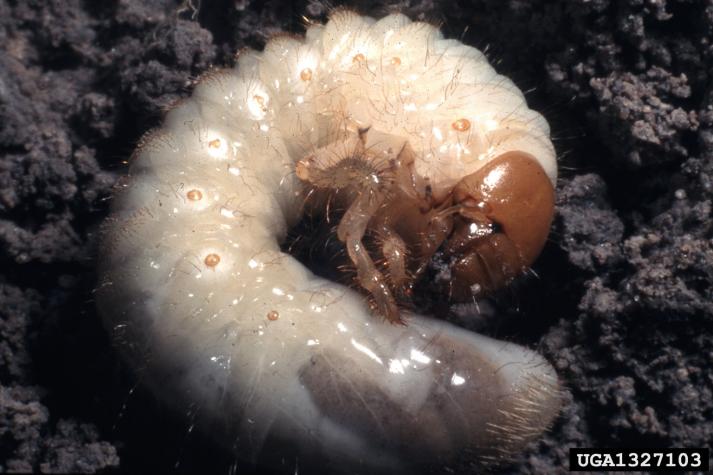COLUMBIA, Mo. –During August, homeowners may notice signs of grubs, an unwelcome annual visitor to healthy, green lawns.
“The earliest symptoms of white grubs feeding on turf grass roots are wilted patches,” said Brad Fresenburg, University of Missouri Extension turf researcher.
Damage may progress from sudden wilting to patches of dead grass. Patches appear when the pest prunes the roots of the grass, leaving dead sod that can be rolled back like a loose carpet, Fresenburg said.
C-shaped, whitish larvae with brown heads will lie in the soil directly below the dead sod. Animals such as skunks or birds digging for grubs can cause further damage.
Grub populations are greater during years with normal to above-normal precipitation. “All white grub species require moist soil for their eggs to hatch,” he said.
Adult species include scarab beetle, May/June beetle, masked chafer, Japanese beetle and black turfgrass ataenius beetle.
Identification of white grub species can be made by size, time of year and the raster patterns on the grub’s abdomen.
Grub populations usually are sporadic, so preventive chemical control isn’t justified except in areas where populations have been perennial.
As a general rule, the best time to treat for grubs is when eggs begin to hatch, which is about four weeks after the adult beetles start to emerge.
Fresenburg said products that seem to have extended activity include imidacloprid (sold under the trade names Grub-Ex and Merit) and halofenozide (sold as Grub-B-Gon and Mach 2).
Sample the grub population to see if chemical treatment is necessary. Cut a one-square-foot piece of sod from several areas of the lawn. Pull back, count the grubs and identify the species. If you have on average more than ten masked chafer grubs or more than five May/June beetle grubs per square foot, chemical treatment is recommended. Always follow the label recommendations when deciding to apply pesticides.
Writer: Robert Thomas
